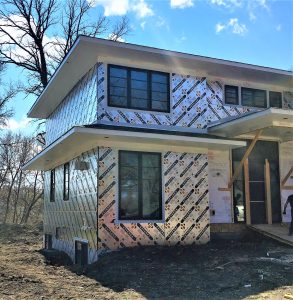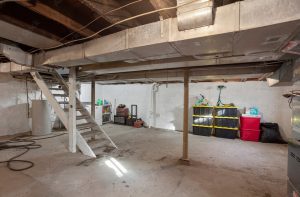Why Halo’s 16 PSI Subterra Plus Is the Better Alternative for Your Project
Whether you’re a builder or an architect, you know that some products have a way of making it into specs and turning up in project after project. Often this can happen with no code requirement or any actual edge over other products.
In this post, we’ll compare XPS Type 4, so often auto-pasted into specs, against a top Graphite Polystyrene (GPS) brand that’s gaining steam as an approved alternate. So let’s take a look at how Type 4 XPS fares against Halo’s 16 psi Subterra Plus in all areas that define an insulation product.
Compressive Strength
The premium you pay for Type 4 XPS has a lot to do with its 30 psi compressive strength, which is achieved by driving up the foam core’s density. It makes sense, doesn’t it? The more gas-filled bubbles you squeeze into a square inch of space, the more material gets used in the process.
But did you know that the 30 psi you pay for with Type-4 is seldom actually needed in many construction projects?

On exterior foundation walls where the insulation is installed vertically, the soil pressures do not warrant that much strength in the insulation.
Neither do residential slabs, light commercial slabs or structural slabs where the slab is supported by piles.
In perspective, a standard 10,000 lb AASHTO H5 truck, on a 6″ concrete slab, will exert less than 1% deflection on 16 psi Subterra Plus. Let’s face it, apart from heavy industrial projects, 30 psi can be overkill and a waste of your client’s money.

Durability
That’s not to say that compressive strength is beside the point with XPS. To a large extent, it is how XPS tries to add durability in order to cope with job-site abuse and the life-cycle wear-and-tear.
While Type-4 XPS looks to add durability from its incremental psi, Halo’s Subterra Plus gets its durability from its cross-woven laminate.
It’s just that Halo’s cross-woven laminate provides far more breakage resistance than XPS’s added foam density, and at a lower cost. It does not crack, it’s not brittle, is resilient and durable in heavy construction conditions, yet is very flexible.

R-Value
R-values, which denote a material’s thermal resistance, is a key feature of any insulation product. Halo’s Subterra Plus – made with GPS – has a similar initial R-value to that of XPS Type 4 and has higher effective R-value to that of XPS Type 2 and Type 3. Subterra’s effective R-value is R-4.7 per inch of thickness.
R-Value Loss Due to Moisture Saturation
When moisture gets inside an insulation product, it fills the tiny voids and pushes out air – the substance that serves as the thermal barrier. Because water transfers heat 24 times faster than air, the foam core quickly loses its insulating properties when it’s soaked.
Sadly, there’s no standard test that offers either a reliable comparison of long-term water absorption between XPS and GPS or its effect on R-values.
The often-cited ASTM C272 does show that GPS initially soaks up more water than XPS – 1.1% vs. 0.7%.
On the other hand, ASTM E96 attests that GPS is more permeable, and therefore sheds more moisture than XPS in the long-term.
By retaining less overall moisture over time, in the end, GPS actually preserves its R-value longer than XPS.
A study, by a leading XPS producer supports this finding. After 15 years of service under highways, a number of XPS products were tested to have absorbed 3% to 7% moisture over 5 to 13 years, much higher than the results of the short term ASTM C272 test.
In another study, this one comparing XPS and EPS products buried for 15 years, the XPS had 19% water absorption and retained 52% of its R-Value, whereas the EPS had 5% water absorption and kept 94% of its R-Value.
This is all not even taking into account that Subterra’s water-proof cross-woven laminate does not even allow moisture to pass through in the first place and so the passage of moisture in and out is limited to the edges of the panels only.
In fact, if you are a specifier that prioritizes water absorption above all other insulation characteristics, then Subterra Plus really has to be your spec of choice!

Don't miss a thing!
Subscribe for exclusive content, insider industry news and limited edition webcasts.
Radon Resistance
Radon is a harmful, radioactive gas that forms as underground uranium breaks down. With no taste, smell, or color, it’s a pervasive threat to our homes.
Based on the Radon Diffusion test administered by the National Research Council of Canada, Halo Subterra Plus is a radon barrier. It is seven times more resistant to Radon than the 6-mil poly vapor barrier, so many builders include Subterra Plus as part of radon-resistant construction (here are instructions for installing Subterra Plus as a radon barrier)
XPS boards, on the other hand, offer no known or documented radon protection.

Cost
While the costs of XPS products vary between regions, Halo’s Subterra Plus typically costs 5% to 20% less than Type 4 XPS.
Considering costs during material selection is a vital part of the design-phase cost control process. When you specify an insulation product, you’re telling your client how much they will pay for an inch of insulation.
Thus, when you auto-paste “XPS Type-4”, you’re compelling your client to spend somewhere between 5%-20% more for a product that offers less overall long term R-Value and performance.
To get an accurate pricing comparison in your region, get a quote from your local materials dealer here.
Wrapping It Up
Construction is a conservative industry, where innovations equal risk and face walls of scrutiny. This aversion to change has led XPS Type-4 to become a staple spec in countless projects without definitive rhyme and reason, or a code requirement. In this post, we compared XPS Type-4 to Halo’s Subterra GPS, an alternative that:
- is more durable
- has longer-lasting R-values
- typically costs less
- serves as a proven radon barrier
- serves as an air and vapor barrier
Before you auto-paste, “XPS Type 4” into your next set of specifications, consider everything your project stands to miss.
Sources
http://www.bountyheadbebop.com/forum/index.php?topic=24.0
https://buildwithhalo.com/product-performance-series/insulating-your-home-with-less-embodied-carbon/
https://buildwithhalo.com/where-to-buy/
https://buildwithhalo.com/halo-subterra/
https://buildwithhalo.com/r-value-calculator/
Dow Highway Report









